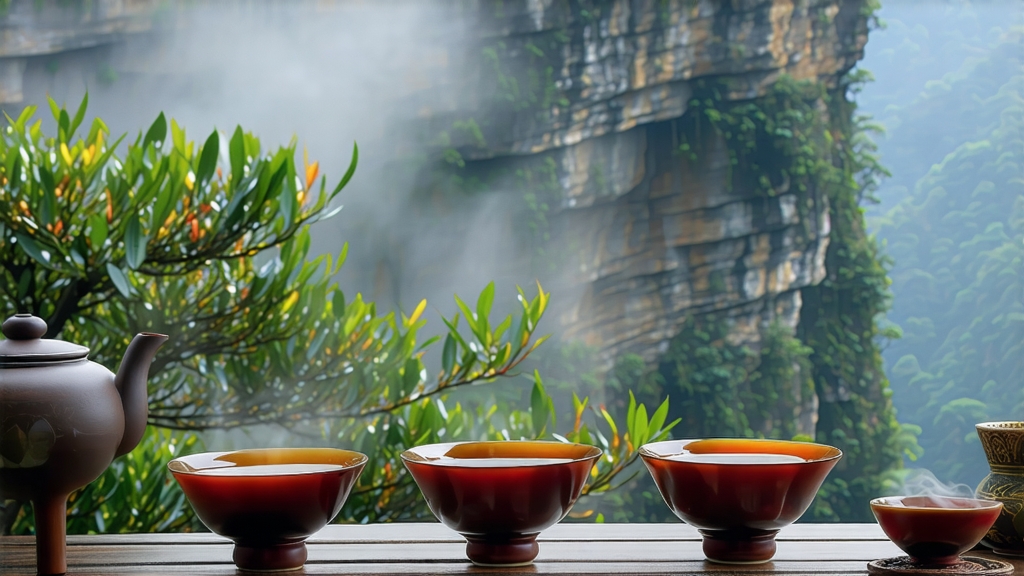
Rougui, literally “cinnamon,” is not a baking spice but one of the most charismatic sub-varieties of Wuyi rock oolong (Yancha). First recorded in the early Qing dynasty, its name refers to a naturally occurring aroma reminiscent of Chinese cassia bark that unfurls after the leaves are fired over charcoal. While the West often associates oolong with the rolled green pellets of Tie Guan Yin, Rougui presents a darker, strip-shaped leaf born from one of the most dramatic terroirs on earth: the 650-million-year-old Danxia cliffs of northern Fujian’s Wuyi Mountains. Jagged granite towers, morning mists that rise from the Nine-Bend River, and a soil layer only centimeters thick force tea roots to probe fissures for minerals, creating the signature “yanyun” or “rock rhyme” that connoisseurs prize above sweetness or fragrance.
From bush to cup Rougui is a lesson in controlled contradiction: it must retain the bright, almost peppery top note of fresh cinnamon while absorbing the deep, toasted character that only smoke and time can bestow. Cultivars are selected from single, old-growth bushes scattered across micro-gullies rather than terraced gardens. The most coveted parcels carry poetic names—Niulan keng (“Cow’s Pen”), Matou yan (“Horse Head Cliff”), Huiyuan keng (“Wise Ape Gully”)—and are so steep that pickers rappel with rope baskets. Harvest takes place for only ten days each late April, when two leaves and a bud are still stiff enough to survive the rigorous processing that follows.
Withering begins in the shade of the cliffs themselves; bamboo trays are laid on narrow ledges where reflected sunlight and cool updrafts coax moisture from the leaf without bruising the edges. Once the leaves feel cool and leathery to the touch, they are shaken in rattan drums every hour through the night, a process called “qing” that initiates edge-oxidation while the center stays green. Mastery lies in reading the aroma that escapes each time the drum opens: first grassy, then guava-like, finally a piercing cinnamon snap that signals the moment to stop. Oxidation is arrested at roughly 40 %—less than the 60 % of traditional Da Hong Pao, more than the 20 % of modern Tie Guan Yin—by plunging the leaves into a 220 °C rolling drum roaster for ninety seconds. What follows is the step that separates Wuyi artisans from every other tea region: three separate charcoal bakes, each lasting six to eight hours, using only the embers of local hardwoods such as Chinese chestnut and cherry. Between bakes the tea rests in unglazed earthen jars for up to a month, allowing moisture deep inside the stem to migrate outward so the next firing can penetrate further. The cycle is repeated until the master judges that the leaf will finish its metamorphosis in the cup rather than in the storage tin.
Judging the roast is therefore the first act of tasting. A properly baked Rougui smells not of smoke but of toasted almond, molasses and the crystallized citrus peel used in Christmas puddings; if you detect acrid tar, the fire was too fierce. The dry leaf should be matte, almost gunmetal, with tiny amber flecks where cinnamon oils have migrated to the surface. When placed in a pre-warmed gaiwan it clinks like porcelain, a sign that the cell walls have become brittle and ready to surrender aroma.
Water is the silent ingredient. Wuyi locals insist on spring water from the same granite range, but internationally the goal is softness: a TDS below 50 ppm lets the minerals in the leaf speak. Heat to a rolling 98 °C; lower temperatures leave the roast clamped shut, while boiling water can scorch the cinnamon esters. The gongfu ratio—1 g leaf to 15 ml vessel—looks extravagant yet is necessary to extract the high-molecular compounds responsible for yanyun. After a flash rinse, the first infusion is five seconds, increasing by three each steep. A porcelain gaiwan is preferred over clay because clay masks the bright top notes; if you must use Yixing, dedicate the pot solely to Rougui for at least a season so the clay learns the aroma.
Watch the liquor evolve: infusion one glows pale apricot with a green rim, releasing a scent like warm snickerdoodle cookies carried